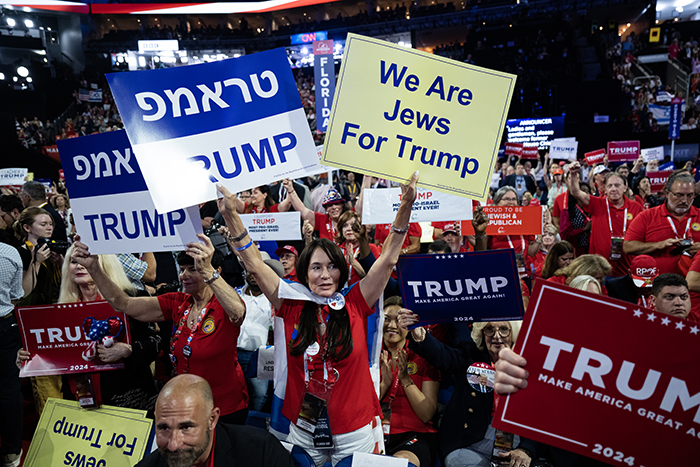Interviews / Geopolitical Observatory of Religion
4 November 2024
United States: What Role Does Religion Play in the Presidential Campaign?

The outcome of the U.S. presidential election, pitting Democrat Kamala Harris against Republican Donald Trump, remains particularly uncertain. Both candidates are making significant efforts to appeal to various social groups, including minorities, among which religious groups play a key role. With a history of numerous waves of immigration and the development of many religious movements on its soil, the United States is characterised by remarkable complexity and diversity in its religious landscape. What role do religions currently play in American society and political life? What are the political preferences of different religious groups? Could they tip the balance in the election? A discussion with Blandine Chélini-Pont, Professor of Contemporary History (International Relations) at Aix-Marseille University and co-author of Catholics and US Politics after the 2020 Elections. Biden Chases the Swing Vote with Marie Gayte and Mark Rozell (Palgrave Macmillan, 2022), conducted by François Mabille, Associate Researcher at IRIS and Director of the Geopolitical Observatory of Religion.
The United States is experiencing another highly uncertain electoral campaign. Both candidates are attempting to mobilise voters by appealing to, and even leveraging, their diverse identities, including religious identities. What is the relationship between the United States, religion, and religious freedom?
In very broad terms, it can be said that the constitutional framework of the Union, preceded by the liberal constitutions of certain states like Virginia, brought an end to established churches and recognised religions, which had previously been accompanied by the prohibition of other faiths and religions in most colonies, marked by significant intolerance, particularly against Catholics. The principle of non-establishment (of an official religion) and freedom of worship (regardless of religion) was ultimately enshrined in one of the amendments that serve as a Bill of Rights to the federal constitution. This amendment was initially second in line, but since the first proposed amendment was not passed, the amendment on religious freedom became the “First Freedom.”
Religious dynamics in the United States were significantly accelerated by this freedom, as well as by the proliferation of churches and the “free” affiliation of new Americans. The historical shaping of the American way of life also incorporated religious practice, which remains remarkably strong even today, from a European perspective. Similarly, religious culture has long served—and continues to serve—to foster civic engagement for causes that can be considered political. Many of these causes historically aligned with the left of the political spectrum (such as the fight against slavery, racism, the struggle for voting rights, and education), while newer causes like environmentalism, migration rights, and the welfare state remain within this spectrum. Other causes have consistently leaned to the right. A significant portion of contemporary American conservatism is deeply rooted in Christian religious culture and proudly claims this heritage.
Globalisation is causing numerous transformations and reorganisations in religious mobility and forms of belonging. What does the current religious landscape in the United States look like?
There is an almost even split in the religious vote across the political spectrum, according to Pew Research Center polls. The Republican Party and its presidential candidate attract the majority of the white Christian electorate, regular churchgoers from the broad evangelical family (which includes fundamentalist churches like the dominionists studied by André Gagné), Pentecostal/charismatic churches (which also have fundamentalist currents), as well as more traditional Protestant denominations—referred to as “mainstream” churches—and conservative Catholics and Orthodox Christians of European origin.
The Democratic Party and its candidate attract “believers” with no religious affiliation (a majority among the so-called “nones”), less observant white Christians, progressive Christians (including members of new inclusive churches welcoming LGBTQ individuals), and traditionally, all electorates from non-Caucasian religious minorities as classified by the U.S. census or more recent categories. Among these, there is a significant number of Catholic minorities. In summary, the Republican Party tends to be “Christian,” while the Democratic Party is more interfaith.
However, this framework, which began to take shape in the 1970s and 1980s, is increasingly shifting among highly observant or fundamentalist racial and non-Christian minorities. The Democratic Party is losing Pentecostal and fundamentalist voters within the Latino and African American electorates. Growing Latino evangelical groups, such as Prosperity Gospel churches (a recent branch of Pentecostalism), for instance, support Donald Trump as their new Messiah. Other small religious electorates have also shifted Republican: Cuban-origin Latinos, religious Jews, Hindus, and others. Additionally, the African American Baptist electorate is reportedly frustrated with the Democrats’ inaction on racial justice, sceptical about voting for a woman—even a woman of colour—and particularly opposed to gay marriage and LGBTQ causes.
Finally, the Gaza war, which began a year ago and is metastasising into a regional conflict, has fractured the Democratic Party’s support among certain voter groups: the “nones” (an expanding demographic), Arab Christians (including Palestinian Christians in Eastern churches), Muslims of Arab and Asian backgrounds, and even a small but notable segment of secular Jews. These voters criticise the Democratic administration for failing to pressure the Israeli government into a ceasefire and for continuing to militarily support and fund a state they perceive as illegitimate and colonialist in origin and nature—a view aligned with that of Western radical left movements.
It is estimated that the Muslim electorate, particularly significant in Michigan, is now lost to Kamala Harris and may, through abstention, cost her this critical swing state. Additionally, another segment of secular Jewish voters may shift to Donald Trump because of the war and the Republican Party’s solidarity with Israel’s Jewish population. This is significant, as secular Jews have traditionally been the most Democratic-leaning of all minority electorates. The war has also reignited the voices of Christian Zionists, a fundamentalist evangelical movement that believes the survival and even territorial expansion of the State of Israel heralds and conditions the return of Christ to Earth. Taken together, these “shifting” electorates increasingly favour the Republican camp.
Where do the major religious groups stand in relation to the candidates?
The more “independent” churches are—those without affiliation to a structured network (referred to as non-denominational churches), even if they may form loose networks—the more likely their pastor-entrepreneurs are to support Donald Trump and urge their congregants to vote, with Trump often meeting them and holding rallies in their buildings. Conversely, the more institutionalised churches are, the less they endorse specific candidates, as is typically the case in Catholic parishes.
Kamala Harris, however, can count on the “official” support of Black Baptist churches, Native American communities, ethnic Catholics, progressive evangelicals, progressive Catholics, and others.


